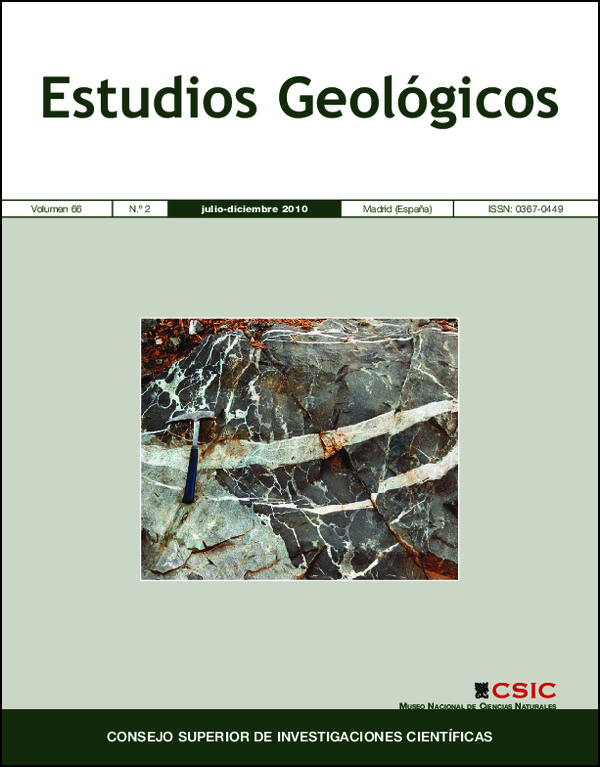Interpretation of magnetic data of the Laachach gossan (central Jebilets, Morocco): mining implications
DOI:
https://doi.org/10.3989/egeol.40123.092Keywords:
Laachach, Central Jebilets, Morocco, gossans, magnetic prospectingAbstract
In the hercynian massif of Central Jebilets (Morocco), outcrop a large number of gossans which sometimes top economical orebodies (Kettara, Draa Sfar, etc.). The present study is devoted to the interpretation of magnetic data covering one of these iron hats, located near of the Laachach village, at about thirty kilometres north-westward of Marrakech. The magnetic map of Laachach highlights several anomalies which coincide with the outcrop of the gossan. Detailed analysis of reduced to the pole data allows us to conclude that these anomalies may be due to submeridian magnetic structures cut by a set of dextral transverse faults. These structures are generally dipping westward but they can be locally sub vertical. The Euler deconvolution of the magnetic data gives moderately deeping solutions (22 to 254 m). The quantitative interpretation of the two principal magnetic anomalies highlighted in the study area lead to better characterising of the deep structure of the Laachach magnetic bodies, that may correspond to massive sulphide occurrences, according to the geological and mining context of the study area. The two modelled bodies constitute priority recognition targets for any mining exploration program to be car ried out on the Laachach site.
Downloads
References
Bernard, A.J.; Maïer, O.W. & Mellal, A. (1988). Aperçu sur les amas sulfurés massifs des Hercynides marocaines. Mineralium Deposita, 23: 104-144. doi:10.1007/BF00206659
Bordonaro, M. (1983). Tectonique et pétrographie du district à pyrrhotine de de Kettara. (Paléozoïque des Jebilets, Maroc). Thèse de 3ème cycle, Université Louis Pasteur, Strasbourg, France, 140 pp.
El Hassani, A. (1980). Etude lithostratigraphique, tectonique et pétrographique de la région de Sidi Bou-Othmane (Maroc). Contribution à la connaissance de l’évolution du segment hercynien des Jebilets centrales. Thèse 3ème Cycle, Université Aix Marseille, Marseille, France, 114 pp.
Essaifi, A. (1995). Relations entre magmatisme-déformation et altération hydrothermale: l’exemple des Jebilets centrales (Hercynien, Maroc), Mémoires Géosciences Rennes, 66: 340 pp.
Essaifi, A.; Potrel, A.; Capdevilla, R. & Lagarde, J.L. (2003). Datation U-Pb: âge de mise en place du magmatisme bimodal des Jebilets centrales (chaîne Varisque, Maroc). Implications géodynamiques. Comptes Rendus Geoscience, 335: 193-203. doi:10.1016/S1631-0713(03)00030-0
Essaifi, A. & Hibti, M. (2008). The hydrothermal system of Central Jebilet (Variscan Belt, Morocco): A genetic association between bimodal plutonism and massive sulphide deposits ? Journal of African Earth Sciences, 50: 188-203. doi:10.1016/j.jafrearsci.2007.09.012
Felenc, J.; Alji, M.; Bellot, A.; Fournier, M.; Mheurras, M. & Jidri, S. (1985). Découverte d’un amas sulfuré caché à pyrrhotite et métaux de base à Hajjar (Massif des Guemassa, Maroc). Chronique de Recherche Minière, 478: 61-66.
Felenc, J.; Fournier, M. & Hmeuras, M. (1986). Contrôles géologiques des amas à pyrrhotine des Jebilets et Guemassa. Définition des guides de recherches. Rapport du Bureau de Recherches Géologiques et Minières, 86 MAR 131, 54 pp.
Hathouti, M. (1990). Etude gravimétrique et magnétique des amas sulfurés viséens de la région de Marrakech. PhD Thesis, Université des sciences et techniques du Languedoc, Centre géologique et géophysique, Montpellier, France, 206p.
Hibti, M. (1993). L’amas sulfuré de Hajjar: contexte géologique de mise en place et déformations superposées (Haouz de Marrakech, Meseta sud-occidentale, Maroc). Thèse de 3ème cycle, Université de Marrakech, Morocco.
Huvelin, P. (1977). Etude géologique et gîtologique du massif hercynien des Jebilets (Maroc occidental). Note et Mémoires du Service Géologique du Maroc, 232 bis, 307 pp.
Lai, S.F. (1984). Generalized linear inversion of two and one-half dimensional gravity andmagnetic data. Ph.D. Thesis, University of Texas at Dallas, USA, 188 pp. Lescuyer, J.L.; Leistel, J.M.; Marcoux, E.;
Milési, J.P. & Thiéblemont, D. (1998). Late Devonian-early Carboniferous peak sulphide mineralization in the Western Hercynides. Mineralium Deposita, 33: 208-220.
Mellal, A. & Maier, O.W. (1988). Recherches d’amas sulfurés dans la province des minéralisations syngénétiques volcano-sédimentaires hercyniennes: cas de Hajar dans le massif des Guemassa. Revue de l’Industrie Minérale, Mines et Carrières, Les Techniques, Mars-Avril, 121-131.
Mickus, K. (2008). Regional gravity analysis of Burkina Faso: Implications for the location of metallic ore deposits, Journal of African Earth Sciences, 50: 55-66. doi:10.1016/j.jafrearsci.2007.09.016
Reid, A.B. (1995). Euler deconvolution: Past, present and future - A review. 65th SEG meeting, Houston, USA, Expanded Abstracts, 272-273.
Thompson, D.T. (1982). EULDPTH - A technique for making computer-assisted depth estimates from magnetic data. Geophysics, 47: 31-37. doi:10.1190/1.1441278
Downloads
Published
How to Cite
Issue
Section
License
Copyright (c) 2010 Consejo Superior de Investigaciones Científicas (CSIC)

This work is licensed under a Creative Commons Attribution 4.0 International License.
© CSIC. Manuscripts published in both the print and online versions of this journal are the property of the Consejo Superior de Investigaciones Científicas, and quoting this source is a requirement for any partial or full reproduction.
All contents of this electronic edition, except where otherwise noted, are distributed under a Creative Commons Attribution 4.0 International (CC BY 4.0) licence. You may read the basic information and the legal text of the licence. The indication of the CC BY 4.0 licence must be expressly stated in this way when necessary.
Self-archiving in repositories, personal webpages or similar, of any version other than the final version of the work produced by the publisher, is not allowed.















